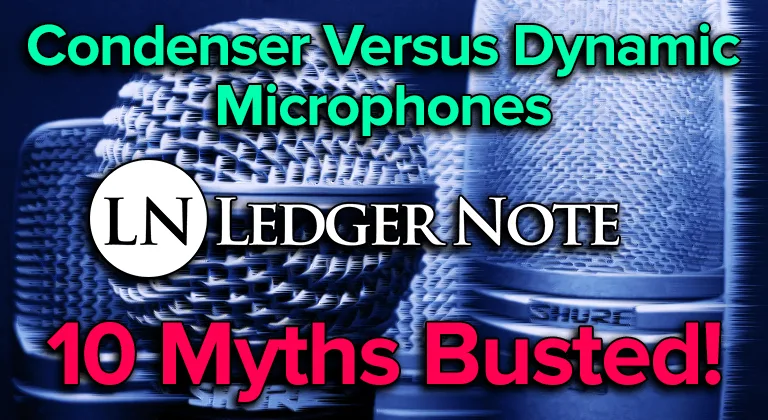
Some of these issues are flat out mythology and categorically false, while others are true in some applications and false in other scenarios.
No wonder there’s a lot of contradiction to be found on message boards and websites. Couple that with people pretending to be more knowledgeable than they are and others simply parroting bad advice and you can quickly see how the confusion continues to perpetuate itself.
Another main issue is that a statement can be made about a condenser or dynamic within a specific context and then someone takes that statement and generalizes it to all contexts. If you aren’t watching out for this you could even find seeming contradictions in Ledger Note articles.
Let’s not worry about who, why, and how this happens.
Let’s cut straight to the chase and get to the bottom of the 10 most common myths surrounding condenser and dynamic mic comparisons and lay it to rest for good!
In no particular order, let’s demolish the 10 most prominent myths about condenser and dynamic mics.
Every single bit of these common misunderstandings arise from the core difference between a dynamic mic and a condenser mic. That difference relates to how the diaphragm interacts with the rest of the circuitry to generate the electrical audio signal. All of this makes up the transducer.
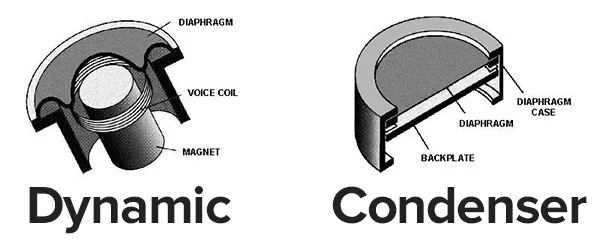
To keep it simple, the diaphragm is like your ear drum. Sound waves hit it and cause it to vibrate and move, which generates electricity. In a dynamic microphone a magnet is moved through a coil.
When a magnet passes through the electro-magnetic field of a coil, it causes electrons to flow in a certain direction (based on the Right Hand Rule).
In a condenser microphone, the diaphragm is one of two plates of a capacitor. A capacitor has two plates that can hold an electrostatic charge between them.
When the diaphragm moves closer to the backplate, the distance between the capacitor plates shortens and some of the electric charge is released.
This, my friends, is what causes all of the rumors and allegations about how they perform and are better or worse at. Let’s crush those myths!
If after you read these you still have a preference for a certain type of mic or it makes sense for a specific use you have, then check out our suggestions in the following buying guides:
Let’s get the myth busting started…
1) Dynamic Mics Don’t Need a Power Supply
Verdict: Mostly True
Somehow this binary idea came to be perpetuated that, while all condenser mics need a power supply, dynamic mics don’t.
It is true that every condenser will at least need 48 volts of phantom power provided by the preamplifier (if not much more supplied by a custom power supply) to charge the capacitor and other items.
It’s true in most cases, but not all, that dynamic mics don’t need some form of power. This is true for passive dynamics where the acoustic energy is enough to generate a decent signal that the preamplifier can boost the rest of the way to line-level.
But some transducer designs are too feeble to even generate a strong mic-level signal with only acoustic energy from the sound waves. This doesn’t mean they produce worse quality.
They just need a power supply, which could even be a battery, to help it along. This is an active microphone and there are active dynamics, but most of them are passive.
2) Dynamic Mics Can Withstand Higher SPL’s Than Condensers
Verdict: Sometimes True
This one is complicated. Due to the construction of the transducer, condenser mics are more sensitive than dynamics. This means they’re typically capable of reproducing slightly more detail at lower volumes, and consequentially they can distort if you place them in front of high sound pressure level (SPL) sources.
So while it is possible to damage a condenser’s diaphragm with too much volume, the common real-world problem is running into distortion issues that reduce your audio quality.
A second problem with condensers and high SPL’s is that condensers can be upwards of ten times more sensitive than a dynamic mic. This means that it can respond with greater differences in voltage.
At extremely loud levels, this means the voltage can get so high as to be sending the preamplifier too hot of a signal to handle, resulting in distortion at the preamp and your analog-to-digital converters.
Condensers, for the most part, can handle a normal SPL blast fine. But they also may distort and send a hot, clipping signal that even the best mic preamp can’t fix.
Dynamics don’t encounter these issues. So condensers can and can’t handle a higher SPL at the same time, depending on your definition.
3) Condenser Mics Are More Fragile Than Dynamics
Verdict: Halfway True
We’re strictly talking about the physical construction now and not SPL levels. For the most part, I’d rather accidentally drop or knock over a mic stand with a dynamic mic on it.
The reason is that there are less moving or fragile parts, with one caveat. Many dynamics are designed for use on the stage and are built like tanks in anticipation of being tossed around and knocked over on tour.
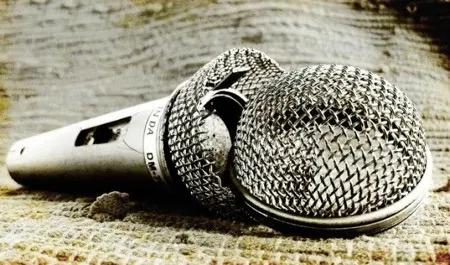
A condenser mic’s transducer is of a more sturdy construction, yet it depends on being finely tuned to produce the level of sensitivity they are built for. Then add the fact that most of them have vacuum tubes that can break upon impact and I just don’t want to go there.
There are solid state condensers without tubes that can take a beating, but again that doesn’t protect the delicate balance of the diaphragm and backplate.
Now think about a dynamic mic’s transducer. It essentially has a floating magnet that has to be able positioned so that the coil can move around it. That magnet probably weighs more than the entire capacitor in a condenser.
So dropping it means that the weight can shift around, bang the coil and diaphragm, etc. So that’s one way a dynamic is truly more fragile, but because it’s working with less sensitivity this kind of mishap may go unnoticed in the final product or live on stage.
4) Condenser Microphones Are Louder Than Dynamics
Verdict: Who Cares?
This is one of those ones where it depends on how you want to play with language. Yes, we concede that a condenser recording the same sound source as a dynamic will pop out a hotter signal than a dynamic due to the sensitivity in terms of voltage. This directly translates to volume amplitude.
But a mic is not an island unto itself. It’s absolutely worthless without a preamplifier. This means that these two items can be seen as one unit. You control the output gain at the preamp, so in the end the discussion of which is louder is irrelevant and a waste of time.
What ends up mattering is the available gain on the preamp. If you’re doing proper gain staging at the preamp then this literally doesn’t matter at all.
We should also note that condenser mics are more sensitive in another fashion, which is picking up subtleties in the audio it’s recording. If loudness is your concern, you probably want to use a dynamic mic anyways.
It is possible to damage the diaphragm in a condenser with sudden bursts of energy or sustained exposure to extremely high sound pressure levels. You’re more likely to get a distorted signal, though. Both are bad.
5) Condenser Mics Produce a Cleaner, Better Signal
Verdict: False
I have no clue where this type of myth comes from. Maybe it’s because a lot of people who play gigs are used to dynamics and associate them only with live performance and think condensers are only for the studio.
It all depends on the especially on the individual mic and on the paired preamp as well. One condenser might have less self-noise than a dynamic. A dynamic might have a lower noise floor and better shielding.
A condenser might be designed as an overhead, boundary, or room mic but is being used for close miking and is spitting out too much low-end. A dynamic might have an even more pronounced proximity effect.
Different model mics are designed for different applications and can be used incorrectly. But is that the mic’s fault?
The problem comes from people trying to take physical and mental shortcuts. These heuristics say “I can set up every mic just like I did the last one and all should be well.” No, no, no. There are no constants in mics or setting them up, which brings us to the next myth.
6) It’s Easier To Set Up Dynamics in the Studio or on Stage
Verdict: Who Comes Up With This Crap?
I realize time is money and we’re all being rushed, but if you’re grabbing a ton of dynamics and putting them in front of people and instruments because you think it’s more fool-proof then you’re fooling yourself.
Sometimes sound guys at the bar are just being lazy or don’t want their expensive condensers being stolen when they can use all Shure SM57’s and SM58’s instead.
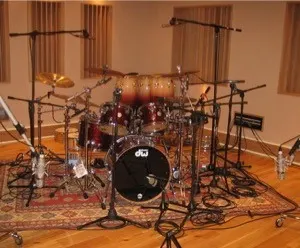
Ninety-nine times out of 100 you’re using a cardioid pickup pattern regardless, so bleed isn’t going to be any more of an issue with a condenser than a dynamic.
Basically, you should never slap a mic on a stand and push it in front of an instrument, mouth, or amplifier without listening intently in your best studio headphones and moving the mic around to find the sweet spot.
There are no shortcuts. Even if you leave a drum kit miked up 24/7 you should still check for each player and each session.
On stage, although neither should feature any more bleed than the other, condensers are more sensitive and may capture with more clarity unwanted noises in the crowd or from other instruments.
What I mean is that these extra sounds may not hide down in the noise floor as easily on a condenser that picks up more subtleties and has less self-noise, even with close-miking.
7) Dynamics are for People with Deep Voices & Vice Versa
Verdict: Sigh…
I hear this one often where it’s asserted that dynamic mics are for people low frequency voices while condensers are for people with high pitched voices.
While it’s true that condensers pick up more details and that higher frequency voices have more complex waveforms going on in the upper registers, that doesn’t mean dynamic mics aren’t capable of capturing or reproducing a higher pitched vocalist’s voice either.
Another item that may contribute to this misconception is the proximity effect that is often more pronounced and controllable in dynamic mics.
I’d say part of what perpetuates this error is the Electro-Voice RE-20, which is the dynamic mic used by most radio DJ’s to get that buttery smooth deeper voice. This is thanks to its very pronounced proximity effect, and not because of any aspect of dynamics in general.

If you want to know how wrong this myth is, let me tell you about the Shure SM7B, pictured above. This mic was used on many singles throughout a certain artist’s career, and was used exclusively on his best selling album, which is also the best selling record of all time.
That album is Thriller and the singer is Michael Jackson, a recording artist known for his high pitched vocals. So don’t let anyone tell you a dynamic can’t record high frequencies. A condenser is just as capable of recording bass frequencies as well.
8) Dynamics Cost Much Less Than Condensers
Verdict: Nope
The fact that a mic is one type and not the other has nothing to do with pricing. It boils down to the research and development costs to refine the mic to the needs of the target demographic; covering manufacturing, shipping, packaging, and marketing costs; and then the pressures of the competitors willing to fight on price.
The Shure SM57 and SM58 mentioned above probably contribute to this myth. They are fantastic, professional microphones that cost relatively very little and can take a crazy beating.
So live venues tend to stock up on these so if they break or are stolen it’s a minor loss. But the idea that categorically dynamics are cheaper is naive. It takes a simple Amazon or Google search to see that it’s nonsense.
Some of the most expensive mics on the market are dynamics. Ribbon mics are even worse. Then again you can find outrageously priced condenser mics too. Every type of microphone has outliers. This flips right into the next myth.
9) Audiophiles Get Duped By Pricing & Marketing of Mics
Verdict: Absolutely
This is weird because everyone interested in recording and playback wants the best results possible. But there’s a group of people come to be known as audiophiles that tend to be very gullible and some companies are happy to exploit them.
It works like this. Some companies produce consumer-level gear and sell it at professional prices to people who don’t know better. Then there’s what we’re talking about here too where professional quality gear is sold at astronomical, cosmic prices that aren’t based on reality.
A lot of jargon and fancy marketing gets tossed around, people fall for the trick where they think the cost is related to the results, and then they use confirmation bias as a defense mechanism against shame of being duped, or get tricked by the placebo effect. They also take pride in bragging about acquiring the most expensive goods.
There’s also a group of people who take pride in keeping it as low-cost and garage-band-ish as possible. Both of these groups have opinions about condenser mics that go along with the myth above.
They are either worth it because they cost more (which they don’t, nor are they categorically better) or they aren’t better but people get duped by the price.
These are the same groups where one person buys a treadmill as if spending money will magically make you less fat and the other person scoffs and says running on the road is just as good anyways. Both ignore the quality of the tennis shoes.
When you blow tons of money on a microphone, you stop getting improvements to the recording quality far earlier in your budget thanks to the higher costs and diminishing returns of research and development.
What you do start getting is access to features, like switches to change through pickup patterns, bass roll-off’s, dim switches to stop from peaking as easy, etc. To think you’re getting more than that when you don’t need those features is a waste of money. And blind listening tests prove it.
For some reason, audiophiles think condenser mics cost more and are better quality because of it. Neither is true.
10) Dynamic Mics Have Better On-Axis Reach Than Condenser Mics
Verdict: What?
This myth isn’t just a misunderstanding of types of mics, but all of them in general. Yes, shotgun microphones can be pointed at specific targets and block out a lot of other noise, but that still has nothing to do with reach. It has to do with blocking off-axis sounds.
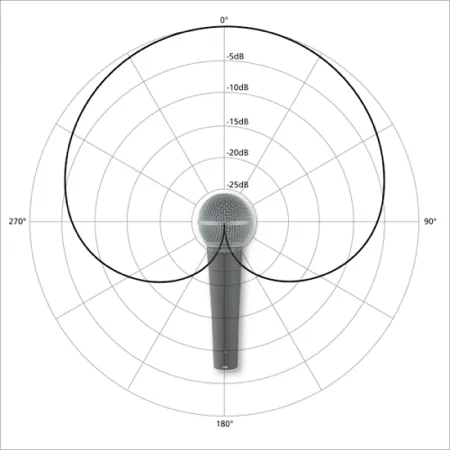
There is no such thing as reach when it comes to recording. No mic is better at picking up an audio source that’s situated further away than any other.
Dynamics and condensers both have access to the same pickup patterns and these have nothing to do with distance, only with directionality, or how many degrees off-axis a source is and how sensitive the mic is to those sounds versus the one it’s pointed at.
So not only is one not better at “reach” than the other, no microphone is better at reach because none of them can reach out for anything.
Bonus Myth: Condenser Mics Only Make Up For a Shoddy Signal Chain
Verdict: No.
Admittedly I’ve only heard or read this myth a few times, but the fact that I encountered it more than once warrants destroying it. Because it’s incredibly silly and is built on willful ignorance.
I call it willful because if you know all about the entire signal chain but still believe the myths listed above then you’re choosing to do so. Otherwise your general knowledge about recording already demolishes the nonsense.
When recording non-electric signals, you always have to use a mic. The mic is the very first piece of the signal chain.
A masterful preamp, equalizer, and compressor can’t magically make up for even the best cheap mic any more than the best studio microphone ever can outpace the damage of sub-par gear affecting the signal after it. It logically falls apart immediately with a few moments of thought.
Bonus Myth: Dynamic Mics Can Sound Different Depending on the Impedance
Verdict: True But Not An Issue
This gets narrowed down to such uncommon situations that you’ll likely never encounter it. What this refers to is the impedance of the preamp input on your mixer, interface, or stand-alone preamplifier.
There’s the rule of making sure there’s at least a 10:1 ratio of terminating load to the microphone or headphone impedance or you under-power and effect the frequency response.
It’s basically like this. If you’re using consumer-level gear then the consumer-level mic will be matched with your consumer-level preamp.
Professional quality preamps and amplifiers typically need to supply more power to overcome the higher impedance of professional mics and headphones. This high impedance is what allows them to be more sensitive to details (has to do with extra coiling).
So unless you’re mismatching a toy with tool, you’re fine here. Also, this doesn’t happen with any active microphones that ensure they have enough power. So now we’re only talking about passive mics with really crappy gear.
The other time is if you try to split a mic signal to two different inputs (I’ve never done this in my life), you need twice the power and likely aren’t delivering it.
So yes, it can happen but is extremely unlikely. The effect is that you don’t have the power to produce the bass and sub-bass frequencies and get a very anemic sounding recording.
Condenser vs. Dynamic Mics: The Battle is Over…

That should do it. Please keep this post in mind so any time some knucklehead on a forum mentions one of these myths you can save your own time and link them here instead of engaging them in argument.
Feel free to proactively share it using the buttons below as well if you know someone who needs to have the myths of condenser vs. dynamic microphones cleared up (defeated in an argument).